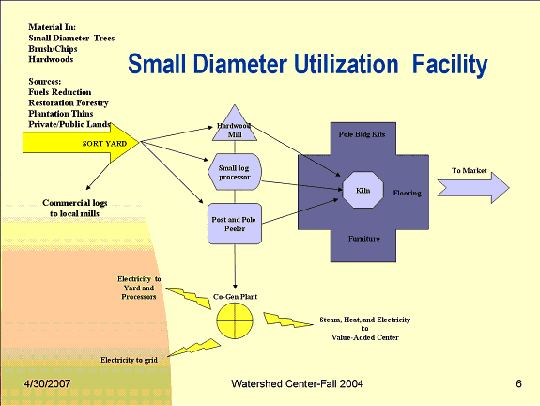Small Diameter Wood Utilization
In order to restore the health of timberlands and to foster economic renewal in rural, forest-dependent communities, the issue of small-diameter wood must be addressed. Due to new technologies in processing, small-diameter logs now can meet standards for high quality and efficient lumber production. The WRTC strives to develop consistent supplies and improve profit margins for this previously sub-merchantable commodity through participation in the Small Diameter Timber Utilization Project. The Project's mission is:
- To establish viable business opportunities from the needed thinning of small diameter trees; including a new integrated model for sorting and merchandizing
- To lessen the threat of catastrophic fire, by clearing small diameter trees while increasing forest health and resiliency
- Through stewardship contracting, to move the small diameter timber from our forested lands, to our local small diameter mill, and onto local craft workers
Chopsticks Administrative Study
Common by-products of forest management are 3 to 10 inch diameter logs from the thinning of plantation pine and suppressed Douglas fir. In the past, the products of thinning by the Forest Service were usually piled and burned in place or sold as chips. In an administrative study called "Chopsticks" conducted with the Forest Service and other organizations, the Watershed Center:
- Developed and demonstrated new extraction technologies
- Tested milling, drying and secondary processing
- Studied marketing of extracted material
- Monitored ecological impacts of alternative harvest methods and site treatments
- Trained dislocated workers in ecosystem management field practices.
The study's results can help the Forest Service turn costly service contracts for treating fuel hazards into income-generating timber sales. The Forest Service sent personnel from Washington D.C. to review what the WRTC had learned about utilizing small diameter thinning.
Regional Demonstrations
The WRTC is a part of the California Multi-Site Small Diameter Wood Project, which encourages local collaborative groups experimenting with the harvest, raw processing and value-added manufacturing of small diameter material. WRTC staff has traveled to various locations in California, Oregon, and Idaho with the Hayfork Yarder and Economizer for small diameter demonstrations. Our Economizer was taken to places such as Covelo, Ca for a harvest demonstration that was attended by local community members and forest workers. The milled products were purchased and transported to buyers. When not being used for demonstrations, the mill is kept at the Hayfork Log Sort Yard to make high quality, eco-friendly wood products.

